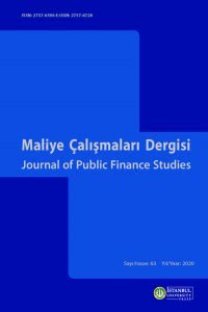Gelişmekte Olan Ülkelerde İç Borçlanma Dinamikleri: Panel Veri Analizi
İç borçlanma, panel veri analizi
DOMESTIC DEBT DYNAMICS IN DEVELOPING COUNTRIES: PANEL DATA ANALYSIS
External debt, Panel Data Analysis,
___
- Abbas, S. M. Ali (2007). “Public Domestic Debt and Economic Growth in Low-Income Countries,” (chapter from doctoral dissertation; Oxford, United Kingdom: Department of Economics, University of Oxford).
- Abula, Adofu, M. (2010). “Domestic Debt and the Nigerian Economy”, Current Research Journal of Economic Theory, (Çevrimiçi) maxwellsci.com/print/crjet/v2-22-26.pdf, 09.07.2011.
- Arnone, Marco, Andrea F. Presbitero (2006). “External Debt Sustainability and Domestic Debt in Heavily Indebted Poor Countries”, Munich Personal RePEc Archive, (Çevrimiçi) http://mpra.ub.uni-muenchen.de/139/, 17.08.2012.
- Beaugrand, Fhilippe, Boileau Loko, Montfort Mlachila (2002). “The Choice Between External and Domestic Debt in Financing Budget Deficit: The Case of Central and West African Countries”, IMF Working Paper, (Çevrimiçi) http://www.imf.org/ external/ pubs/ft/wp/2002/wp0279.pdf, 05.09.2012.
- Blejer, Mario I. (1986). “Public Debt and Fiscal Policy in Developing Countries”, IMF Working Paper, (Çevrimiçi) http://papers.ssrn.com/sol3/papers.cfm?abstract_id=884531, 24.07.2012
- BM (2007). “Recent Development in External Debt”, Report of the Secretary-General, 26 Jul 2007.
- Borensztein, Eduardo v.d., (2004). “Sovereign Debt Structure for Crisis Prevention”, IMF Occasional Paper, (Çevrimiçi) http://www.imf.org/external/np/res/docs/2004/070204.pdf, 02.07.2011.
- Borensztein, Eduardo, Levy Yeyati Eduardo, Ugo Panizz (2007). Living With Debt: How The Limit The Risks of Sovereign Finance, Inter-American Development Bank, Economic and Social Progress in Latin America, 2007 Report.
- Bulutoğlu, Kenan (2004). Kamu Ekonomisine Giriş: Demokraside Devletin Ekonomik Bir Kuramı, Batı Türkeli Yayıncılık, İstanbul 2004. Burger, John D., and Francis E. Warnock (2006). “Foreign Participation in Local-Currency Bond Markets”, International Finance Discussion Papers, (Çevrimiçi) http://elsa.berkeley.edu /users/eichengr/af/warnock.pdf, 24.08.2012.
- CADTM (2008). “Developing Countries: Dangerous Times for the Internal Public Debt”, (Çevrimiçi) http://www.cadtm.org/Developing-countries-dangerous, 20.04.2010.
- Chamon, Marcos, Ricardo Hausmann (2002). “Why Do Countries Borrow the Way They Borrow?”, (Çevrimiçi) http://www.hks.harvard.edu/fs/rhausma/paper/chamon_hausmann.pdf
- Claessens, Stijn, Daniela Klingebiel, Sergio L. Schmukler (2007). “Government Bonds in Domestic and Foreign Currency: The Role of Institutional and Macroeconomic Factors”, (Çevrimçi) http://siteresources.worldbank.org/DEC/Resources/SchmuklerRIE.pdf, 25.07.2012.
- Cural, Mehmet (2012). Kalkınmanın Finansmanında Kamu İç-Dış Borç Yapısı, İstanbul Üniversitesi, Sosyal Bilimler Enstitüsü, Maliye Anabilim Dalı, Yayınlanmamış Doktora Tezi, İstanbul 2012.
- Daniel, Laurent (2008). “Foreign Investors’ Participationin Emerging Market Economies’ Domestic Bond Markets”, Banque de France, Quarterly Selection of Articles, (Çevrimiçi), http://www.banque-france.fr/fileadmin/user_upload/banque_de_france/173etud2.pdf, 28.10.2012
- Duran, Mahmut (1996). “Kamu Finansman Açıklarının Optimal Finansmanı”, Kamu Kesimi Finansman Açıkları, 10. Maliye Sempozyumu, Mayıs 1994, Antalya, İstanbul Üniversitesi Basımevi, No.554, İstanbul 1996.
- Eichengreen, Barry, Ricardo Hausmann, Ugo Panizza (2003). “The Pain of Original Sin”, (Çevrimiçi) http://elsa.berkeley.edu/~eichengr/research/ospainaug21-03.pdf, 20.01.2012.
- Forslund, Kristine (2008). “The Determinants of The Composition of Public Debt in Developing and Emerging Countries”, UNCTAD Discussion Paper, (Çevrimiçi) http://www.sciencedirect.com/science/article/pii/S187993371100025X, 02.06.2012.
- Goode, Richard (1984). Government Finance in Developing Countries, The Brookings Institution, Washington, D.C., 1984.
- Guscina, Anastasia (2008). “Impact of Macroeconomic, Political, and Institutional Factors on the Structure of Government Debt in Emerging Market Countries”, IMF Working Paper, (Çevrimiçi), http://www.imf.org/external/pubs/ft/wp/2008/wp08205.pdf, 07.06.2012.
- Hanson, James A. (2007). “The Growth in Government Domestic Debt: Changing Burdens and Risks”, World Bank Policy Research Working Paper, No.4348, Septemper 2007, (Çevrimiçi), http://elibrary.worldbank.org/content/workingpaper/10.1596/1813-9450-4348, 25.08.2010.
- IMF (2003), “Public Debt in Emerging Markets: is it too High?” World Economic Outlook 2003, Çevrimiçi) http://www.imf.org/external/pubs/ft/weo/2003/02/pdf/chapter3.pdf, 10.10.2012.
- Lima, Lycia, Ugo Panizza, Kristine Forslund (2008). “The Determinants ofThe Composition of Public Debt in Developing and Emerging Countries”, UNCTAD Discussion Paper, (Çevrimiçi) http://www.sciencedirect.com/science/article/pii/S187993371100025X, 21.10.2012.
- Margolin, D. (2007). “Financial Stability and Local Currency Bond Markets”, Committee on the Global Financial System Papers, (Çevrimiçi) http://www.bis.org/publ/cgfs28.pdf, 20.04.2012.
- Paincheira, Juan Pablo (2009). “Finansallaşma Çağında Gelişmekte Olan Ülkeler: Açık Birikiminden Rezerv Birikimine”, çev. Sabriye Biçen, Finanskulüp, Maliye ve Finans Yazıları, Sayı 82, Ocak 2009.
- Panizza, Ugo (2008). “Domestic and External Public Debt in Developing Countries”, BM, UNCTAD Discussion Paper, No.188, March 2008, (Çevrimiçi) http://unctad.org/en/docs/osgdp20083_en.pdf, 08.04.2012.
- Reinhart, Carmen M., Kenneth S. Rogoff (2007). “The Forgotten History of Domestic Debt”, NBER Working Paper Series, 13946, (Çevrimiçi) http://www.nber.org/papers/w13946, 24.07.2011.
- Şen, Hüseyin v.d. (2008). Kalkınmanın Finansmanı, Kalkınma Ekonomisi Seçme Yazılar, Editörler, Sami Taban ve Muhsin Kar, 2.Baskı, Ekin Yayınevi.
- Tarı, Recep (2010). Ekonometri, 6.Baskı, Umuttepe Yayınları, Kocaeli, 2010.
- Tatoğlu, Ferda Yerdelen (2011). Panel Veri Ekonometrisi, Beta Yayınevi, İstanbul.
- World Bank (2005), Global Development Finance 2005: Mobilizing Finance and Managing Vulnerability (Çevrimiçi), http://siteresources.worldbank.org/GDFINT/Resources/334952-1257197866375/gdf05complete.pdf, 07.11.2012.
- Yavuz, H. Hakan (2009). “Kamu Borç Yönetiminde Yabancı Para Cinsinden Borçlanmanın Etkileri: Türkiye Örneği”, Maliye Dergisi, Sayı 157, Temmuz-Aralık.
- ISSN: 2757-6396
- Başlangıç: 1955
- Yayıncı: İstanbul Üniversitesi
Doğal Afetlerin Doğurduğu Koşullu Mali Yükümlülükler
Türkiye’de Kamu Harcamaları ve Kamu Gelirlerinin Bölgesel Analizi
Gökhan DÖKMEN, Abdullah TEKBAŞ
Gecikme Faizinde 6322 Sayılı Yasa ile Yapılan Düzenlemelere İlişkin Değerlendirmeler
Yasemin TAŞKIN, Elif SONSUZOĞLU
Uluslararası Para Fonu’nun Kredilendirme Mekanizması: Düşük Gelirli Ülkelere Yönelik Bir İnceleme
Gelişmekte Olan Ülkelerde İç Borçlanma Dinamikleri: Panel Veri Analizi
